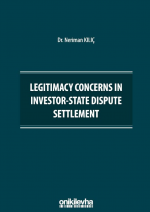 Arbitration has become the most common method for the investor-state disputes settlement (ISDS), and under the current system of ISDS disputes are not settled by a single adjudicative body, instead investment arbitration is conducted by a number of tribunals. The fragmented nature of the system of ISDS and International Investment Law (IIL) coupled with the lack of a regulatory body has given rise to certain concerns of illegitimacy such as the issues of regulatory chill, lack of transparency, consistency and coherence. Considering the significance of the Foreign Direct Investment (FDI) for all parties involved, it is essential to have a legitimate and well-organised system for the adjudication of investment disputes. Furthermore, as investment dispute frequently involve issues that relate to public interest, it is argued that to be considered legitimate the adjudication system should be reliable, predictable, consistent and transparent. The absence of these key features is what creates the legitimacy crisis that the current system is allegedly suffering. Therefore, it is extremely important that the issue of legitimacy of the system of ISDS and possible reforms are thoroughly and comprehensively studied and discussed - this research fulfils this need by evaluating the concept of legitimacy and the concerns surrounding the system of ISDS in great detail.(ARKA KAPAKTAN)
Arbitration has become the most common method for the investor-state disputes settlement (ISDS), and under the current system of ISDS disputes are not settled by a single adjudicative body, instead investment arbitration is conducted by a number of tribunals. The fragmented nature of the system of ISDS and International Investment Law (IIL) coupled with the lack of a regulatory body has given rise to certain concerns of illegitimacy such as the issues of regulatory chill, lack of transparency, consistency and coherence. Considering the significance of the Foreign Direct Investment (FDI) for all parties involved, it is essential to have a legitimate and well-organised system for the adjudication of investment disputes. Furthermore, as investment dispute frequently involve issues that relate to public interest, it is argued that to be considered legitimate the adjudication system should be reliable, predictable, consistent and transparent. The absence of these key features is what creates the legitimacy crisis that the current system is allegedly suffering. Therefore, it is extremely important that the issue of legitimacy of the system of ISDS and possible reforms are thoroughly and comprehensively studied and discussed - this research fulfils this need by evaluating the concept of legitimacy and the concerns surrounding the system of ISDS in great detail.(ARKA KAPAKTAN)
Table of Contents
Chapter 1. Introduction
1.1. Background
1.2. Significance of the Problem
1.3. Research Questions
1.4. Brief Overview of Literature
1.5. Methodology and the Originality of the Research
Chapter 2. The Legitimacy of the Investor-State Dispute Settlement (ISDS) System
2.1. Introduction
2.2. Belief in Legitimacy
2.3. Conclusion
Chapter 3. The Issue of Regulatory Space in International Investment Law
3.1. Introduction
3.2. Defining the Right to Regulate
3.3. Refinement of Investment Standards
3.4. General Exception Clauses
3.5. Insertion of Positive Language Regarding Regulatory Interests in International Investment Agreements
3.6. Conclusion
Chapter 4: The Principles of Transparency and Confidentiality in International Investment Arbitration
4.1. Introduction
4.2. Current Trends on Transparency in ISDS
4.3. Advantages and Disadvantages of the Principles of Transparency and Confidentiality
4.4. Balancing Transparency with Confidentiality in ISDS
4.5. Conclusion
Chapter 5. Issue of Inconsistency and Parallel Proceedings
5.1. Introduction
5.2. Degree of Consistency and Role of Arbitrators
5.3. Factors that lead to the 'crisis of inconsistency'
Chapter 6 - Possible Solutions
6.1. Introduction
6.2. The Creation of a Multilateral Agreement on Investment
6.3. A Case for the Establishment of a Permanent Two-tiered Investment Court
6.4. An Interim Measure
6.5. Conclusion
Chapter 7: Conclusion
7.1. Overview of the Research
Bibliography
